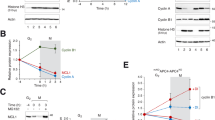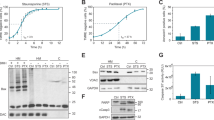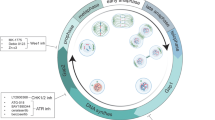Abstract
Cancer cells often have unstable genomes and increased centrosome and chromosome numbers, which are an important part of malignant transformation in the most recent model of tumorigenesis. However, very little is known about divisional failures in cancer cells that may lead to chromosomal and centrosomal amplifications. In this study, we show that cancer cells often failed at cytokinesis because of decreased phosphorylation of the myosin regulatory light chain (MLC), a key regulatory component of cortical contraction during division. Reduced MLC phosphorylation was associated with high expression of myosin phosphatase and/or reduced myosin light-chain kinase levels. Furthermore, expression of phosphomimetic MLC largely prevented cytokinesis failure in the tested cancer cells. When myosin light-chain phosphorylation was restored to normal levels by phosphatase knockdown, multinucleation and multipolar mitosis were markedly reduced, resulting in enhanced genome stabilization. Furthermore, both overexpression of myosin phosphatase or inhibition of the myosin light-chain kinase in nonmalignant cells could recapitulate some of the mitotic defects of cancer cells, including multinucleation and multipolar spindles, indicating that these changes are sufficient to reproduce the cytokinesis failures we see in cancer cells. These results for the first time define the molecular defects leading to divisional failure in cancer cells.
This is a preview of subscription content, access via your institution
Access options
Subscribe to this journal
Receive 50 print issues and online access
$259.00 per year
only $5.18 per issue
Buy this article
- Purchase on Springer Link
- Instant access to full article PDF
Prices may be subject to local taxes which are calculated during checkout







Similar content being viewed by others
References
Amano M, Ito M, Kimura K, Fukata Y, Chihara K, Nakano T et al. (1996). Phosphorylation and activation of myosin by Rho-associated kinase (Rho-kinase). J Biol Chem 271: 20246–20249.
Eda M, Yonemura S, Kato T, Watanabe N, Ishizaki T, Madaule P et al. (2001). Rho-dependent transfer of Citron-kinase to the cleavage furrow of dividing cells. J Cell Sci 114: 3273–3284.
Fujiwara T, Bandi M, Nitta M, Ivanova EV, Bronson RT, Pellman D . (2005). Cytokinesis failure generating tetraploids promotes tumorigenesis in p53-null cells. Nature 437: 1043–1047.
Geigl JB, Obenauf AC, Schwarzbraun T, Speicher MR . (2008). Defining ‘chromosomal instability’. Trends Genet 24: 64–69.
Gu LZ, Hu WY, Antic N, Mehta R, Turner JR, de Lanerolle P . (2006). Inhibiting myosin light chain kinase retards the growth of mammary and prostate cancer cells. Eur J Cancer 42: 948–957.
Ikebe M, Hartshorne DJ . (1985). Phosphorylation of smooth muscle myosin at two distinct sites by myosin light chain kinase. J Biol Chem 260: 10027–10031.
Ikebe M, Koretz J, Hartshorne DJ . (1988). Effects of phosphorylation of light chain residues threonine 18 and serine 19 on the properties and conformation of smooth muscle myosin. J Biol Chem 263: 6432–6437.
Ito M, Nakano T, Erdodi F, Hartshorne DJ . (2004). Myosin phosphatase: structure, regulation and function. Mol Cell Biochem 259: 197–209.
Kaneko K, Satoh K, Masamune A, Satoh A, Shimosegawa T . (2002). Myosin light chain kinase inhibitors can block invasion and adhesion of human pancreatic cancer cell lines. Pancreas 24: 34–41.
King RW . (2008). When 2+2=5: the origins and fates of aneuploid and tetraploid cells. Biochim Biophys Acta 1786: 4–14.
Komatsu S, Yano T, Shibata M, Tuft RA, Ikebe M . (2000). Effects of the regulatory light chain phosphorylation of myosin II on mitosis and cytokinesis of mammalian cells. J Biol Chem 275: 34512–34520.
Kosako H, Goto H, Yanagida M, Matsuzawa K, Fujita M, Tomono Y et al. (1999). Specific accumulation of Rho-associated kinase at the cleavage furrow during cytokinesis: cleavage furrow-specific phosphorylation of intermediate filaments. Oncogene 18: 2783–2788.
Lemez P, Michalova K, Zemanova Z, Marinov I, Trpakova A, Moravcova J et al. (1998). Three cases of near-tetraploid acute myeloid leukemias originating in pluripotent myeloid progenitors. Leuk Res 22: 581–588.
Lothschutz D, Jennewein M, Pahl S, Lausberg HF, Eichler A, Mutschler W et al. (2002). Polyploidization and centrosome hyperamplification in inflammatory bronchi. Inflamm Res 51: 416–422.
Lucero A, Stack C, Bresnick AR, Shuster CB . (2006). A global, myosin light chain kinase-dependent increase in myosin II contractility accompanies the metaphase-anaphase transition in sea urchin eggs. Mol Biol Cell 17: 4093–4104.
Madaule P, Eda M, Watanabe N, Fujisawa K, Matsuoka T, Bito H et al. (1998). Role of citron kinase as a target of the small GTPase Rho in cytokinesis. Nature 394: 491–494.
Moussavi RS, Kelley CA, Adelstein RS . (1993). Phosphorylation of vertebrate nonmuscle and smooth muscle myosin heavy chains and light chains. Mol Cell Biochem 127-128: 219–227.
Nigg EA . (2006). Origins and consequences of centrosome aberrations in human cancers. Int J Cancer 119: 2717–2723.
Olaharski AJ, Sotelo R, Solorza-Luna G, Gonsebatt ME, Guzman P, Mohar A et al. (2006). Tetraploidy and chromosomal instability are early events during cervical carcinogenesis. Carcinogenesis 27: 337–343.
Park SH, Maeda T, Mohapatra G, Waldman FM, Davis RL, Feuerstein BG . (1995). Heterogeneity, polyploidy, aneusomy, and 9p deletion in human glioblastoma multiforme. Cancer Genet Cytogenet 83: 127–135.
Poperechnaya A, Varlamova O, Lin PJ, Stull JT, Bresnick AR . (2000). Localization and activity of myosin light chain kinase isoforms during the cell cycle. J Cell Biol 151: 697–708.
Rhodes DR, Kalyana-Sundaram S, Mahavisno V, Varambally R, Yu J, Briggs BB et al. (2007). Oncomine 3.0: genes, pathways, and networks in a collection of 18 000 cancer gene expression profiles. Neoplasia 9: 166–180.
Schenker T, Trueb B . (1998). Down-regulated proteins of mesenchymal tumor cells. Exp Cell Res 239: 161–168.
Scholey JM, Taylor KA, Kendrick-Jones J . (1980). Regulation of non-muscle myosin assembly by calmodulin-dependent light chain kinase. Nature 287: 233–235.
Shackney SE, Smith CA, Miller BW, Burholt DR, Murtha K, Giles HR et al. (1989). Model for the genetic evolution of human solid tumors. Cancer Res 49: 3344–3354.
Shi Q, King RW . (2005). Chromosome nondisjunction yields tetraploid rather than aneuploid cells in human cell lines. Nature 437: 1038–1042.
Silverman-Gavrila RV, Forer A . (2001). Effects of anti-myosin drugs on anaphase chromosome movement and cytokinesis in crane-fly primary spermatocytes. Cell Motil Cytoskeleton 50: 180–197.
Sluder G, Nordberg JJ . (2004). The good, the bad and the ugly: the practical consequences of centrosome amplification. Curr Opin Cell Biol 16: 49–54.
Takanishi Jr DM, Hart J, Covarelli P, Chappell R, Michelassi F . (1996). Ploidy as a prognostic feature in colonic adenocarcinoma. Arch Surg 131: 587–592.
Thompson SL, Compton DA . (2008). Examining the link between chromosomal instability and aneuploidy in human cells. J Cell Biol 180: 665–672.
Tohtong R, Phattarasakul K, Jiraviriyakul A, Sutthiphongchai T . (2003). Dependence of metastatic cancer cell invasion on MLCK-catalyzed phosphorylation of myosin regulatory light chain. Prostate Cancer Prostatic Dis 6: 212–216.
Van Eldik LJ, Watterson DM, Burgess WH . (1984). Immunoreactive levels of myosin light-chain kinase in normal and virus-transformed chicken embryo fibroblasts. Mol Cell Biol 4: 2224–2226.
Wang Q, Hirohashi Y, Furuuchi K, Zhao H, Liu Q, Zhang H et al. (2004). The centrosome in normal and transformed cells. DNA Cell Biol 23: 475–489.
White JS, Weissfeld JL, Ragin CC, Rossie KM, Martin CL, Shuster M et al. (2007). The influence of clinical and demographic risk factors on the establishment of head and neck squamous cell carcinoma cell lines. Oral Oncol 43: 701–712.
Word RA, Casey ML, Kamm KE, Stull JT . (1991). Effects of cGMP on [Ca2+]i, myosin light chain phosphorylation, and contraction in human myometrium. Am J Physiol 260: C861–C867.
Xia D, Stull JT, Kamm KE . (2005). Myosin phosphatase targeting subunit 1 affects cell migration by regulating myosin phosphorylation and actin assembly. Exp Cell Res 304: 506–517.
Acknowledgements
We thank Dr David J Hartshorne (University of Arizona) for kindly providing the UPCI:SCC103 cell line and HEK293 with the MYPT1 expression cell line, respectively. We are also grateful to Dr Jeffrey D Hildebrand (University of Pittsburgh), Dr Anne R Bresnick (Albert Einstein College of Medicine), Dr Kathleen Kelly (National Cancer Institute), Dr David J Hartshorne (University of Arizona) and Dr James T Stull (University of Texas Southwestern Medical Center) for plasmids and antibodies. We also thank Dr Xiaojing Wang (University of Pittsburgh) for helpful discussions regarding statistical analysis and Dr Jian Huang (University of Texas Southwestern Medical Center) for helpful suggestions about urea glycerol electrophoresis. This study was supported in part by NIH grants R01DE016086 to WSS and SMG and R01DE14729 to SMG and WSS. Cytogenetic analyses were carried out in the UPCI Cytogenetics Facility, supported in part by NIH grant P30CA47904 to Ronald B Herberman/SMG.
Author information
Authors and Affiliations
Corresponding author
Ethics declarations
Competing interests
The authors declare no conflict of interest.
Additional information
Supplementary Information accompanies the paper on the Oncogene website
Supplementary information
Rights and permissions
About this article
Cite this article
Wu, Q., Sahasrabudhe, R., Luo, L. et al. Deficiency in myosin light-chain phosphorylation causes cytokinesis failure and multipolarity in cancer cells. Oncogene 29, 4183–4193 (2010). https://doi.org/10.1038/onc.2010.165
Received:
Revised:
Accepted:
Published:
Issue Date:
DOI: https://doi.org/10.1038/onc.2010.165
Keywords
This article is cited by
-
Mitotic protein kinase-driven crosstalk of machineries for mitosis and metastasis
Experimental & Molecular Medicine (2022)
-
Loss of MLCK leads to disruption of cell–cell adhesion and invasive behavior of breast epithelial cells via increased expression of EGFR and ERK/JNK signaling
Oncogene (2016)
-
Isoform-specific functions of Mud/NuMA mediate binucleation of Drosophilamale accessory gland cells
BMC Developmental Biology (2014)



